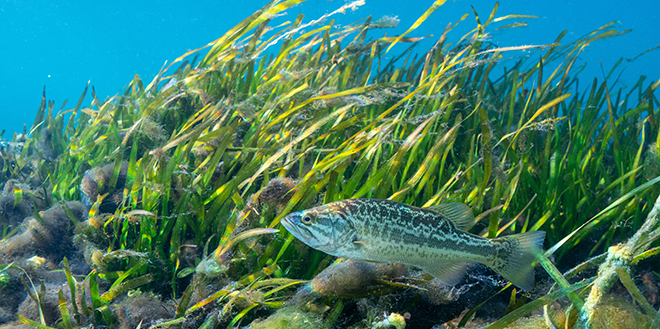Submerged aquatic vegetation, or SAV, is a critical component of estuarine ecosystems. The St. Johns River and Indian River Lagoon just to our south are examples of what can happen when the delicate balance of environmental factors is impacted.
The most common species of SAV in this area is Vallisneria americana, commonly called eel-grass but also named tape-grass or water celery. But it looks nothing like celery to me. V. americana is a fresh-water species that can tolerate some salt. With fresh water being zero salt and full-strength sea water being 35 parts per thousand, tape-grass can live in salinities varying from its preferred fresh water to about 18 parts per thousand for short periods of time. The exact limit to the salt tolerance is unclear and is generally dependent on the duration and intensity of the plants’ exposure to the saline water along with other environmental factors.
Like any plant, SAV requires sunlight, lots of sunlight, to photosynthesize and thrive. And with the dark tannin-rich waters of the St. Johns, that means the plants can only grow in shallow water. Below about 3 feet, the amount of sunlight is insufficient to support plant life. Anything that diminishes the amount of light, like sediment runoff that clouds the water and increases the turbidity, also reduces the amount of plant life.
Excess nutrients entering the water can trigger algae blooms that lower the amount of sunlight available to SAV. Sometimes those algae blooms can be toxic themselves. That is what is happening in Tampa Bay right now. The discharge of thousands of gallons of phosphate-loaded water from the Piney Point incident back in March has led to a devastating algae bloom and fish kill in the Tampa/Sarasota area today.
Something similar to Piney Point has happened in the Indian River Lagoon over the last few years. Nutrient-rich water has been gradually discharged in the lagoon. This increases the amount of algae in the water and decreases available sunlight for the SAV, resulting in a net loss of vegetation to support animals like our beloved charismatic megafauna, the manatee.
Over the last several decades, manatees have made a comeback, from their path to extinction to a path where their numbers were increasing consistently. There had been some concern about having enough food for the expanding manatee population, but until recently, that had not been a major concern. However, evidence seems to indicate that manatees are dying from starvation, especially in the Indian River Lagoon.
SAV has been dramatically reduced in the St. Johns River’s lower basin as the salinity has gradually increased over the last few decades. Hurricane Irma also had a dramatic impact on the amount of grass in the river. The good news is that SAV is making a gradual comeback. A loose-knit group of volunteers is monitoring the progress. So, there is still room to hope that some of the SAV will return. And while the loss of SAV has not been identified as a current threat to manatees in the St. Johns River, the possibility does exist.
Glad you asked River Life
What are some of your favorite memories from your career as a marine scientist?
Thank you for asking. I had to pause and think about all that I had done over my career. Top of the list is the number of incredibly fascinating people that I have had the pleasure to meet and to learn from their knowledge and understanding. I have been repeatedly reminded how kind and generous scientists are with sharing what they know. Second, is the number of places I have been able to travel and experience, from diving to 1,500 feet deep in the submersible Sea-Link in the Bahamas, to numerous trips to the Galapagos, China, Japan, Australia, and to diving the Great Barrier Reef. Marine science has offered me countless opportunities to explore and learn from the world’s oceans. I have been truly blessed during my entire career.
River Life runs the first Tuesday of each month in The Florida Times-Union. E-mail Quinton White, executive director of Jacksonville University’s Marine Science Research Institute, with questions about our waterways at qwhite@ju.edu. For more on the MSRI, visit ju.edu/msri.
 Wave Magazine Online Jacksonville University News Hub
Wave Magazine Online Jacksonville University News Hub

